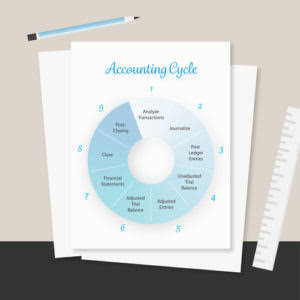
Our AI-powered Anomaly Management Software helps accounting professionals identify and rectify potential ‘Errors and Omissions’ throughout the financial period so that teams can avoid the month-end rush. The AI algorithm continuously learns through a feedback loop which, in turn, reduces false anomalies. We empower accounting teams to work more efficiently, accurately, and collaboratively, enabling them to add greater value to their organizations’ accounting processes. It allows users to extract and ingest data automatically, and use formulas on the data to process and transform it. In this blog, we will discuss the income summary account in detail and understand how to calculate it with some real-world examples.
- For our purposes, assume that we are closing the books at the end of each month unless otherwise noted.
- At this point in the accounting cycle, all the temporary accounts have been closed and zeroed out to permanent accounts.
- Therefore, a post-closing trial balance will include a list of all permanent accounts that still have balances.
- If the company profits for the year, the retained earnings will come on the debit side of the income summary account.
How to close a revenue account?
The term „net“ relates to what’s left of a balance after deductions have been made from it. Retained earnings are defined as a portion of a business’s profits that isn’t paid out to shareholders but is rather reserved to meet ongoing expenses of operation. My Accounting Course is a world-class educational resource developed by experts to simplify accounting, finance, & investment analysis topics, so students and professionals can learn and propel their careers. Shaun Conrad is a Certified Public Accountant and CPA exam expert with a passion for teaching. After almost a decade of experience in public accounting, he created MyAccountingCourse.com to help people learn accounting & finance, pass the CPA exam, and start their career. Here we see that total expenses for both were $9,650 for January 2020.
Closing Journal Entries

The company can make the closing entry for expenses by debiting the income summary account and crediting all expenses accounts. A sole proprietor or partnership often uses a separate drawings account to record withdrawals of cash by the owners. Although the drawings account is not an income statement account, it is still classified as a temporary account and needs a closing journal entry to zero the balance for the next accounting period. To close the revenue accounts for Bob’s Donut Shoppe, we need to debit the revenue account and credit the income summary account. This will ensure that the balances of the revenue account are transferred to the income summary account.
- For instance, the year 2020 revenue and expense accounts would show the balances pertaining to just that year and not for 2019 or 2018.
- Similarly, the debit balances on the expense’s accounts are transferred and zeroed out by debiting the income summary and crediting the individual expenses account.
- Next, if the Income Summary has a credit balance, the amount is the company’s net income.
- Once this process is complete, a post-closing trial balance is prepared which helps in preparation of the balance sheet.
- Income and expenses are closed to a temporary clearing account, usually Income Summary.
- Temporary accounts include all revenue and expense accounts, and also withdrawal accounts of owner/s in the case of sole proprietorships and partnerships (dividends for corporations).
- Advisory services provided by Carbon Collective Investment LLC (“Carbon Collective“), an SEC-registered investment adviser.
Income summary debit or credit
In addition, if the accounting system uses subledgers, it must close out each subledger for the month prior to closing the general ledger for the entire company. If the subsidiaries also use their own subledgers, then their subledgers must be closed out before the Cash Flow Management for Small Businesses results of the subsidiaries can be transferred to the books of the parent company. You record the income summary amount by adding the total expenses and total income and then transferring them to the balance sheet. All of Paul’s revenue or income accounts are debited and credited to the income summary account.

An income summary account summarizes all the operating and non-operating business activities on one page and concludes the company’s financial performance. As the drawings account is a contra equity account and not an expense account, it is closed to the capital account and not the income summary or retained earnings account. If your revenues are greater than your expenses, you will debit your income summary account and credit your retained earnings account. Temporary accounts differ from permanent accounts, which do not need to be opened and closed each period as they show the ongoing financial position of a business.
Looking To Get Started?

Use the chart below to determine which accounts are decreased by debits and which are decreased by credits. Each accounting period’s data must be contained within the designated time frame in order Online Accounting to accurately depict the financial standings of the company. Income summary effectively collects NI for the period and distributes the amount to be retained into retained earnings. Balances from temporary accounts are shifted to the income summary account first to leave an audit trail for accountants to follow. Income summary is a holding account used to aggregate all income accounts except for dividend expenses. It’s not reported on any financial statements because it’s only used during the closing process and the account balance is zero at the end of the closing process.

The purpose of the income summary is to show the net income (revenue less expenses) of the business in more detail before it becomes part of the retained earnings account balance. After the closing journal entry, the balance on the dividend account is zero, and the retained earnings account has been reduced by 200. After crediting your income summary account $5,000 and debiting it $2,500, you are left with $2,500 ($5,000 – $2,500). Because this is a positive number, you will debit your income summary account income summary account and credit your retained earnings account. You need to create closing journal entries by debiting and crediting the right accounts.
Example 4: Closing Dividend Account
It is used when a company chooses to transfer the balance of individual revenue and expense accounts directly to retained earnings or when a company chooses to close the books using an income statement. The income summary account is an intermediate account that is used to close the books. It is used when a company chooses to transfer the balance of individual revenue and expense accounts directly to retained earnings. The income summary account is also used when a company chooses to close the books using an income statement. Once the temporary accounts have all been closed and balances have been transferred to the income summary account, the income summary account balance is transferred to the capital account or retained earnings. The income summary account does not have a normal balance because it is a temporary account used to summarize revenues and expenses.
Post navigation
At the end of each accounting period, businesses prepare an income summary and an income statement. The balances in the temporary accounts are retained in the income summary account until final closing entries are completed. Once all temporary accounts have been closed, the balance in the income summary account should equal the company’s net income for the year. Since dividend and withdrawal accounts are not income statement accounts, they do not typically use the income summary account. These accounts are closed directly to retained earnings by recording a credit to the dividend account and a debit to retained earnings.
